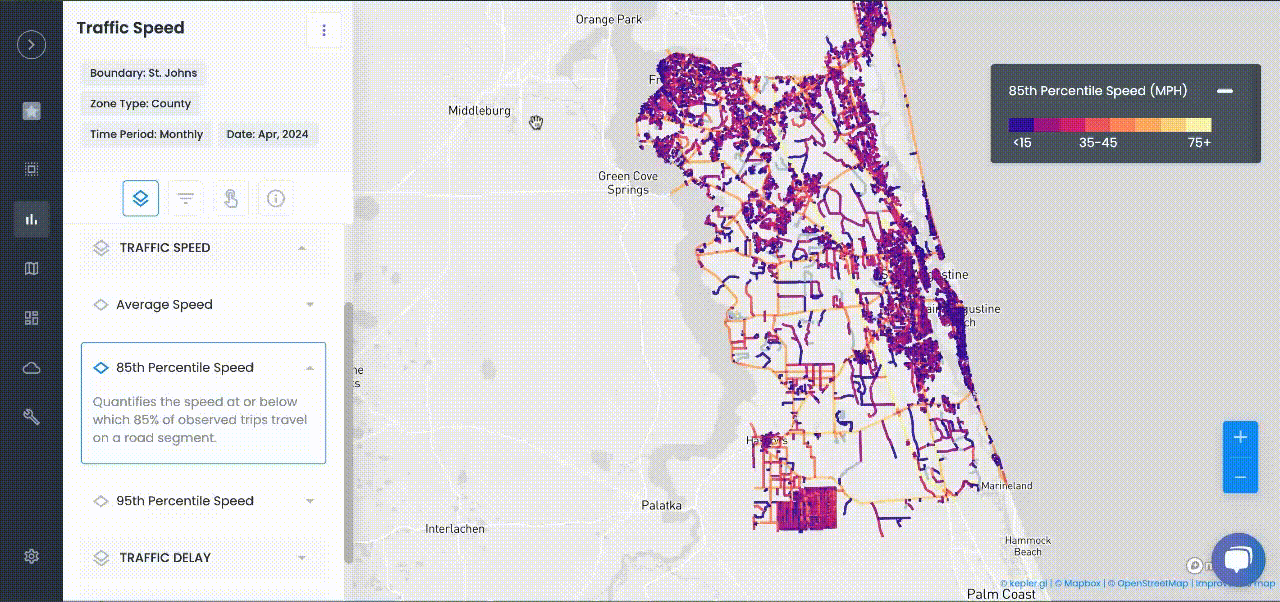
Road Safety
Using Real-Time Violation Data to Improve School Zone Safety
Cities are using traffic data and insights to reduce speeding, prevent crashes, and protect students.
Improve school zone safety with real-time violation data. Learn how cities use live insights to reduce speeding, prevent crashes, and protect students.
Keeping school zones safe isn’t just about setting speed limits—it’s about making sure drivers actually follow them. Every morning and afternoon, school streets become high-risk zones filled with crossing children, parents in a rush, buses, bikes, and unpredictable traffic flow. In those brief windows, a single speeding driver can mean the difference between a safe arrival and a life-changing tragedy.
Traditional enforcement methods like signage, patrol cars, and static cameras have their place. But they often fall short when it comes to fast-changing road conditions and evolving driver behavior. Most tools are reactive—responding only after a crash, a complaint, or a near miss.
That’s where real-time violation data becomes a game changer.
For city leaders and transportation officials working toward Vision Zero, Safe Routes to School, or broader traffic calming initiatives, using live data to monitor and respond to driver violations as they happen is one of the most effective strategies to reduce speeding and protect students where and when it matters most.
In this guide, we’ll break down what real-time violation data is, how it works, and how forward-thinking cities are leveraging it to make smarter, faster decisions that keep school zones safer for everyone.
Why Real-Time Matters in School Zones
School zones are unlike other traffic environments—they operate in short, high-risk bursts. Morning arrivals, midday activity, and afternoon dismissals create windows of intense pedestrian and vehicle interaction. During these narrow time frames, streets fill with children walking, biking, exiting school buses, or crossing busy intersections—many of whom are distracted or still learning how to safely navigate traffic.
Even small lapses in driver attention or speed control during these moments can lead to devastating outcomes.
Yet, the way many cities monitor these zones hasn’t kept pace with the reality on the ground. Traditional enforcement tools—like once-a-year speed studies, crash reports, or citizen complaints—are often too slow, too infrequent, and too narrow to offer a true picture of what’s happening in real time.
These tools typically miss:
- Daily violation spikes that happen during drop-off and pickup
- Time-specific risk patterns, like speeding just after the crossing guard leaves
- Weather-related trends, such as increased near misses in rain or fog
- Behavioral shifts after signage is installed or enforcement levels change
By the time this data is reviewed—weeks or even months later—opportunities to intervene may already be gone.
That’s where real-time violation data fills the gap.
Instead of relying on lagging indicators, traffic officials can access a live feed of what's happening at the moment. Whether it's a speeding violation near a crosswalk, a driver running a red light at school dismissal, or a cluster of hard braking events suggesting near misses, real-time data provides an up-to-the-minute pulse on risk.
This kind of insight gives public leaders the ability to:
- Detect unsafe conditions as they emerge
- Adjust patrol or camera coverage dynamically
- Identify risk patterns by time, location, or behavior
- Take preventive action before crashes occur
With real-time violation data, safety professionals aren’t reacting to yesterday’s problems—they’re solving today’s.
How Real-Time Data Improves Safety Outcomes
Using real-time violation data allows cities to shift from reactive decision-making to proactive intervention. Instead of relying on outdated reports or community complaints, public leaders gain immediate insight into unsafe driver behavior as it happens—enabling faster, more targeted responses that protect students and pedestrians.
Here’s how it leads to safer school zones:
Faster Response to Dangerous Trends
Traditional approaches often rely on quarterly crash data or resident feedback, which means officials are responding to problems long after they’ve occurred.
Real-time violation data changes that by revealing dangerous patterns—such as excessive speeding, red-light running, or illegal passing of school buses—as they emerge.
For example, if a specific crosswalk near a middle school shows a surge in speeding violations during the 2:45–3:15 PM dismissal window, transportation teams can respond that same day by dispatching patrol units, activating dynamic signage, or deploying mobile speed trailers.
This immediate response helps prevent collisions before they happen and addresses unsafe behaviors in the moment, not weeks later.
Dynamic Enforcement Scheduling
Not all school zones experience the same risks at the same times. Some see morning congestion, others face late-afternoon speeding, and some fluctuate based on seasonal factors or weather.
Real-time data allows cities to schedule enforcement resources—like officers, camera vans, or traffic calming devices—based on current conditions.
Instead of static patrol routes or blanket enforcement, cities can shift resources to match live risk levels. This makes enforcement not only more efficient but also more effective, ensuring that the right locations get the right attention exactly when it’s needed.
Evidence-Based School Safety Planning
When making decisions about infrastructure upgrades or enforcement policy, data-backed planning is key.
Real-time violation data provides the evidence cities need to justify investments like permanent speed cameras, curb extensions, raised crosswalks, or pedestrian signals.
Heatmaps showing violation density and time-of-day trends add credibility to proposals presented to school boards, grant committees, or community members.
Rather than relying on isolated complaints, planners can show measurable risk backed by continuous data—making it easier to secure funding, prioritize interventions, and align safety planning with actual need.
Accountability for Impact
Implementing a new camera or safety measure is only part of the solution—cities also need to measure whether those interventions are working.
Real-time violation data provides instant feedback on the success of any safety initiative. Officials can compare pre- and post-intervention metrics like average vehicle speed, violation rates, or hard braking events.
This enables public leaders to report back to the community with transparency and confidence. In fact, New York City’s school zone speed camera program reported a 72% average drop in speeding violations at camera-equipped locations during operational hours—demonstrating just how effective targeted, data-driven enforcement can be.
This kind of measurable impact not only strengthens public trust but also helps refine future strategies by showing what’s working—and where further action may be needed.
How Urban SDK Supports Real-Time Violation Monitoring
Our geospatial AI platform is designed specifically to meet the needs of public leaders and traffic safety professionals working to make school zones safer, smarter, and more responsive. Rather than relying on one-time studies or static data snapshots, we equip cities with continuous, block-by-block visibility into traffic violations and high-risk driving behaviors—exactly where children are walking and crossing.
Using our real-time mobility tools, agencies can track speed violations down to the corridor level, monitor patterns hour by hour, and generate live heatmaps showing when and where risk spikes. But it goes beyond just raw data. Our platform allows teams to cross-reference violations with pedestrian activity, school zone schedules, and past crash history—giving a complete, contextual view of risk.
From there, cities can generate risk scores for each road segment, receive automated alerts when conditions worsen, and access pre- and post-intervention dashboards to measure the effectiveness of speed cameras, signage, or patrol shifts. Whether it’s identifying enforcement hotspots or justifying future infrastructure improvements, every decision is backed by live, defensible evidence.
This is how our clients move from reacting after crashes to preventing them in real time.
Want to see it in action? Explore our Traffic Speed Data and AI Traffic Calming Solutions to learn how our platform supports proactive school zone safety—from the first violation to the final decision.
Key Benefits for City Leaders
Real-time violation data isn’t just a tool—it’s a strategic asset that empowers public leaders to make better decisions, build stronger community trust, and deliver measurable safety outcomes.
Here’s how our platform supports city officials in their mission to protect school zones and elevate transportation safety:
Pinpoint Risk with Precision
Forget general assumptions or outdated maps. Our platform helps city leaders understand exactly where and when violations are occurring—down to the block and hour.
Whether it’s speeding during dismissal or red-light running during lunch hours, you get a precise, time-stamped view of risk. This means resources can be directed where they’re needed most, not just where people complain the loudest.
Time Enforcement for Maximum Impact
Data shows that violations aren’t evenly distributed throughout the day. With our live dashboards, cities can align enforcement with peak danger windows—like morning drop-offs or rainy afternoon dismissals—ensuring officers, cameras, or signage are deployed when they’re most likely to prevent harm.
This not only improves safety, but also maximizes the return on limited enforcement budgets.
Track Trends and Measure Change
Behavior change doesn’t happen overnight—but with real-time trend tracking, city leaders can see whether interventions are working.
Has speeding dropped since a camera was installed? Are fewer near misses happening at that crosswalk?
Instead of anecdotal feedback, you'll have clear metrics to show what’s improving—and where attention is still needed.
Justify Investments with Confidence
Whether you’re presenting to city council or applying for a federal Safe Streets grant, data matters.
Our platform gives you the evidence you need to justify speed camera installations, signal timing upgrades, or permanent traffic calming projects.
Proposals backed by real-time violation data carry more weight—and are more likely to get funded.
Build Trust Through Transparent Engagement
Sharing safety data with parents, school boards, and community members strengthens public trust.
When residents can see why decisions are being made—backed by actual data on violations and outcomes—they’re more likely to support enforcement, education, and infrastructure efforts.
Our visual dashboards make it easy to communicate complex insights in clear, transparent ways.
A Smarter, Safer Path Forward
Improving school zone safety shouldn’t rely on guesswork or outdated reports. With real-time violation data, cities can act with precision, urgency, and confidence—saving lives, preventing injuries, and making every school journey safer for children and families.
At Urban SDK, we believe data should do more than inform—it should empower. Empower transportation teams to respond faster. Empower planners to invest smarter. And empower communities to trust the systems designed to protect them.
Because in today’s connected cities, safety isn’t just a priority—it’s a responsibility. And the right data makes all the difference.

TRAFFIC ENFORCEMENT FEATURES
80% of citizen complaints
are a perception problem
Urban SDK provides precise hourly speed data to evaluate complaints and deploy resources efficiently for the greatest impact to public safety.
Urban SDK provides precise hourly speed data to evaluate complaints and deploy resources efficiently for the greatest impact to public safety.
Target Speeding
Identify hot spots, validate monthly speeding trends and monitor vulnerable areas like school zones.
Improve Safety
Crash and citations location information to compare speed trends month over month
Fast Response
Respond to citizen complaints sooner with address search and exportable reporting
Deploy Assets
Generate maps for traffic enforcement by time of day, location or division to deploy officers to known problem areas.
RESOURCES
Customer Success
See how public sector leaders succeed with Urban SDK.
WEBINAR
Identify speeding and proactively enforce issues
See just how quick and easy it is to identify speeding, address complaints, and deploy officers.







